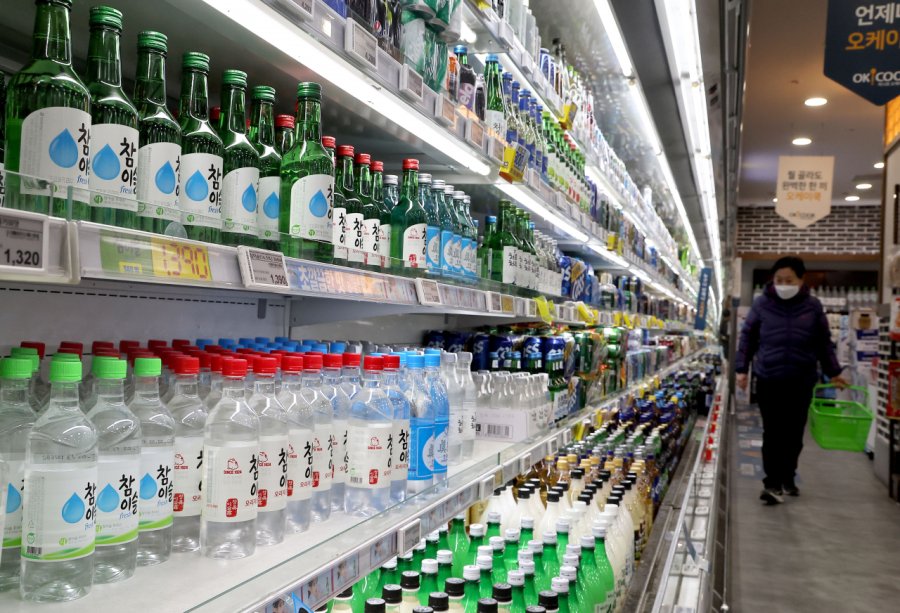March 7, 2023
SEOUL – Rumors of soju price hikes have stirred public disquiet over the past couple of weeks here, intensifying to the extent that the government decided to intervene in the market.
The fuss temporarily ended after Hite Jinro, the country’s largest soju maker, officially announced that it was not planning on any price hikes.
“I felt bitter when I heard about possible price hikes in soju, which seemed to hold out well, while everything else is getting more expensive,” said Kim, a 29-year-old Seoulite.
“It used to be around 15,000 won ($11.43) for five bottles of soju (at restaurants), but now it has been almost doubled. People who have been drinking soju for a long time might feel the huge difference,” said Lee, a 40-years-old who lives in Gyeonggi Province.
The public in South Korea has been sensitive to price increases in soju, not just because it is the most widely consumed alcoholic beverage, but also because, as the cheapest option, it has been branded as a working-class drink.
But soju was not always a cheap option. Traditionally, soju was a beverage that most people could not afford due to the large amount of rice required to make it.
The soju products that most people consume nowadays — known sometimes as diluted soju because it is mixed with water and has a relatively low alcohol content — became popular during the 1960s, under Park Chung-hee’s military regime, according to Im Jeong-bin, Agricultural and Resource Economics professor at Seoul National University.
“Traditional soju is made with rice. But, because the country suffered from a rice shortage during the 1960s, the government banned rice-based soju and makgeolli production,” Im said.
The ban on rice-based liquor production was part of the Grain Management Act that was enacted in 1965. “The Grain Management Act was the government’s price-control measure. Keeping prices down for rice, the country’s staple grain, was important for the country to keep labor cheap, which helped the (economy) grow fast.
Soju products that use potato as the main ingredient — current formulations mainly use tapioca — were introduced in the market to replace traditional soju. They became popular thanks to their cheap prices.

A man walks by the liquor section at a discount store located in Seoul. (Yonhap)
The image of soju being a cheap drink has lingered since then. Soju prices were kept lower even after South Korea became self-sufficient in rice in the late 1970s.
In 1974, a bottle of soju was close to 100 won, while a bottle of beer was priced over 200 won.
People got used to the taste of the cheap diluted liquor, Im said. “Many people still prefer tapioca-based cheap, diluted soju over traditional soju products as well as many other drinks options because they got accustomed to it,” Im noted.
The soju industry was able to see rapid and unparalleled growth also because of South Korea’s protective trade policies in the past.
Before 2000, the liquor tax rate levied on soju products was 35 percent, significantly lower than the tax rate on imported distilled spirits.
Even after the tax rate on soju increased to 72 percent in 2000, soju remained a lot cheaper than other distilled spirits, because the initial price is so low. Korean liquor taxes are based on the value of a product, rather than volume or alcohol content.
According to National Tax Service data, a total of 2.29 billion 360-milliliter bottles of soju were shipped out in 2021. The figure means that Korean adults consume an average of 52.9 bottles of soju per person each year.

The popularity, however, is double-edged particularly when it comes to price policies. Soju makers cannot easily hike prices due to the potential public backlash.
The government cannot just sit idle either.
“Although the government does not, and cannot, directly intervene in soju manufacturers’ price-setting for soju products, it is true that the government’s pressure has existed,” an industry source told The Korea Herald on condition of anonymity.
“The recent government’s intensive probe into liquor prices was part of that government’s pressure,” the source said.
Earlier in February, Deputy Prime Minister and Minister of Economy and Finance Choo Kyung-ho also said, “particular items, including soju, are products that the public enjoys and is keenly interested in,” at a plenary session of the National Assembly’s Strategy and Finance Committee. Choo also asked the industry to actively cooperate in order to stabilize the price of soju and other major consumer goods.
The Ministry of Economy and Finance previously said it would look into the overall soju industry, including earnings of soju manufacturers, as well as whether there are other issues in the soju market, which is dominated by a small number of key players.
People, however, have shown different opinions regarding the government’s involvement in soju prices.
“Price hikes in final products are natural when prices of raw materials increase. The government’s intervention in soju prices is undesirable,” said Sejong University business administration professor Kim Dae-jong.
Another Gyeonggi Province resident The Korea Herald spoke to questioned the markup restaurants put on soju.
“I think the government should more thoroughly review why there is such a gap and take actions there, instead of just pressuring soju makers,” he said.
Currently, the factory price of a bottle of soju is around 1,100 won, while prices vary from 5,000 won to 7,000 won at restaurants.


